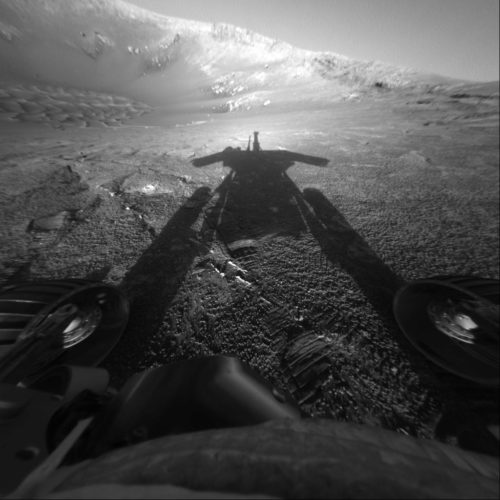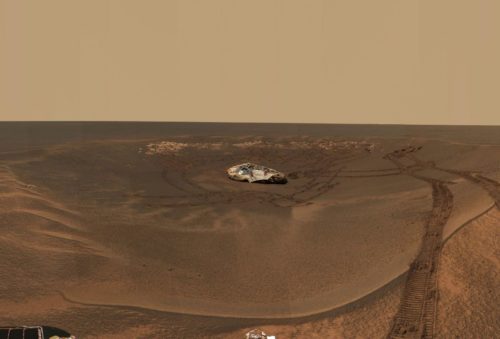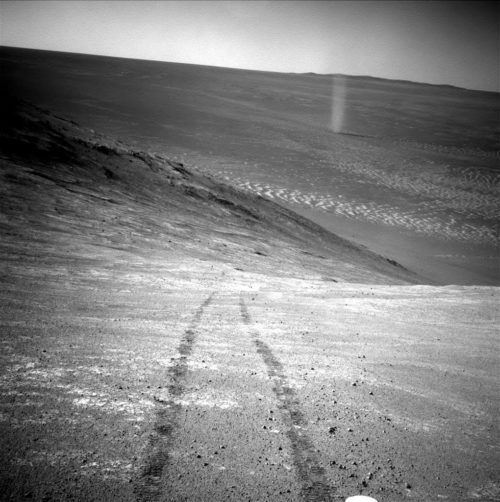
It’s been a long 15 years, but the inevitable has finally happened: the Opportunity rover’s days of exploring Mars are over. The sad news was announced this morning at 2 pm ET in a NASA press briefing, bringing an official end to one of the most successful Mars missions in history.
“It is because of trailblazing missions such as Opportunity that there will come a day when our brave astronauts walk on the surface of Mars,” said NASA Administrator Jim Bridenstine. “And when that day arrives, some portion of that first footprint will be owned by the men and women of Opportunity, and a little rover that defied the odds and did so much in the name of exploration.”
Opportunity, like its twin, Spirit, was designed for a hoped-for nominal mission of 90 Martian days (sols) when it landed in 2004, but lasted for an incredible 15 years. That is 60 times its projected life span.
The mission plan also called for Opportunity to travel at least 1,100 yards (1,000 meters), but ended up roving more than 28 miles (45 kilometers) altogether.

“For more than a decade, Opportunity has been an icon in the field of planetary exploration, teaching us about Mars’ ancient past as a wet, potentially habitable planet, and revealing uncharted Martian landscapes,” said Thomas Zurbuchen, associate administrator for NASA’s Science Mission Directorate. “Whatever loss we feel now must be tempered with the knowledge that the legacy of Opportunity continues – both on the surface of Mars with the Curiosity rover and InSight lander – and in the clean rooms of JPL, where the upcoming Mars 2020 rover is taking shape.”
The trouble began in June 2018, when Opportunity’s location – and most of the planet – was hit with a massive dust storm. June 10 was the last time that the rover was heard from. Up until last night, NASA engineers sent over 1,000 radio commands to try to revive the rover, to no avail. The final transmission was sent via the 70-meter Mars Station antenna at NASA’s Goldstone Deep Space Complex in California.
“We have made every reasonable engineering effort to try to recover Opportunity and have determined that the likelihood of receiving a signal is far too low to continue recovery efforts,” said John Callas, manager of the Mars Exploration Rover (MER) project at JPL.

Opportunity had survived dust storms and other hazards before, but this time was different unfortunately.
It had been hoped that the rover simply “went to sleep” when the power in its solar panels became too low, and would revive later after the dust storm had ended. But it didn’t. Opportunity had also recently been in a period where stronger seasonal winds would blow off dust more easily, as had happened numerous times before, but that also did not work. So why didn’t Opportunity wake up?
As noted by Emily Lakdawalla on Twitter:
It may be that simple, that Opportunity just wasn’t able to be revived due to other mechanical and/or software problems, even if its solar panels had been cleaned off of dust.
Opportunity landed on Jan. 24, 2004 in Meridiani Planum, 20 days after its twin, Spirit, landed in Gusev Crater. Spirit kept exploring until May 2011, after it became stuck in deep sand and was unable to free itself.
Opportunity escaped its own similar predicament, Purgatory Dune, back in 2005.
Opportunity’s landing site was a treasure trove of geologic wonders, with bright patches of bedrock seen in the first images sent back. That bedrock provided evidence for past water in the region, as did the famous “blueberries” – hematite concretions, never seen before on Mars. Opportunity also found the first evidence for ancient salty playa lakes and groundwater on this now mostly-dry world. Important discoveries, since the rover’s overall mission was to determine the past habitability of this region of Mars.
“From the get-go, Opportunity delivered on our search for evidence regarding water,” said Steve Squyres, principal investigator of the rovers’ science payload at Cornell University. “And when you combine the discoveries of Opportunity and Spirit, they showed us that ancient Mars was a very different place from Mars today, which is a cold, dry, desolate world. But if you look to its ancient past, you find compelling evidence for liquid water below the surface and liquid water at the surface.”
The rover explored vast plains, deep craters and steep hills, and watched dust devils, as it continued its exploration over the years. Some of the most notable moments include:
- Set a one-day Mars driving record March 20, 2005, when it traveled 721 feet (220 meters).
- Returned more than 217,000 images, including 15 360-degree color panoramas.
- Exposed the surfaces of 52 rocks to reveal fresh mineral surfaces for analysis and cleared 72 additional targets with a brush to prepare them for inspection with spectrometers and a microscopic imager.
- Found hematite, a mineral that forms in water, at its landing site.
- Discovered strong indications at Endeavour Crater of the action of ancient water similar to the drinkable water of a pond or lake on Earth.
“When I think of Opportunity, I will recall that place on Mars where our intrepid rover far exceeded everyone’s expectations,” Callas said. “But what I suppose I’ll cherish most is the impact Opportunity had on us here on Earth. It’s the accomplished exploration and phenomenal discoveries. It’s the generation of young scientists and engineers who became space explorers with this mission. It’s the public that followed along with our every step. And it’s the technical legacy of the Mars Exploration Rovers, which is carried aboard Curiosity and the upcoming Mars 2020 mission. Farewell, Opportunity, and well done.”


“Opportunity’s final days were spent in Perseverance Valley, an ancient gully thought to have been carved by water or ice, on the edge of Endurance Crater.
“I cannot think of a more appropriate place for Opportunity to endure on the surface of Mars than one called Perseverance Valley,” said Michael Watkins, director of JPL. “The records, discoveries and sheer tenacity of this intrepid little rover is testament to the ingenuity, dedication, and perseverance of the people who built and guided her.”
Meanwhile, NASA’s other Mars rover, Curiosity, continues its mission in Gale Crater and the InSight lander is now ready to start investigating the deep interior of Mars.
Opportunity was beloved by many people – scientists and the public alike – and so became more than just a robot. This quote in Rebecca Boyle’s obituary to Opportunity sums it up nicely:
“It’s odd to think about grief being associated with a machine. But it’s a part of our lives.” – Mark Lemmon
More information about Opportunity is available on the mission website.
.
.
FOLLOW AmericaSpace on Facebook and Twitter!
.
.






Sometime in the future, mankind will find and once again touch Opportunity. It will forever remain a testament to our quest for exploring the unknown and stand as a towering technical and scientific achievement.